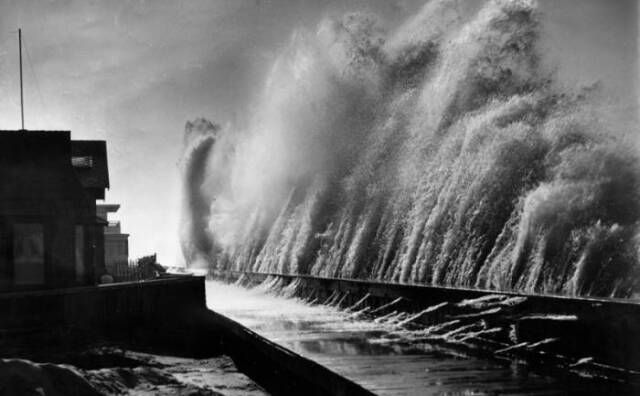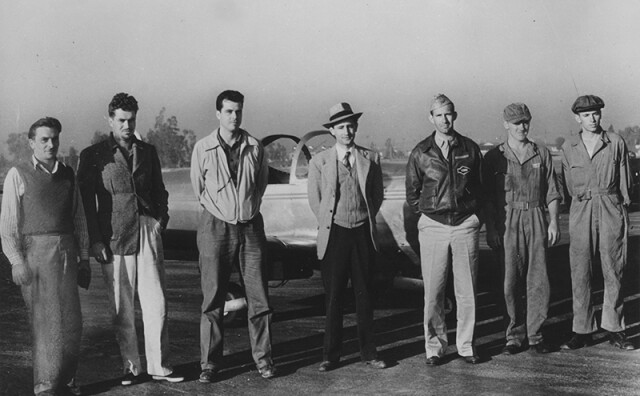Take A Walk From LA's 'Great Hiking Era' And Stroll Back In Time

Like many Angelenos, journalist Charles Fleming didn't always think of the City of Angels as a walker's paradise.
"I was a car guy and a motorcycle guy - not a walking guy, especially not when I was in L.A. - until I was sidelined by back problems and back surgeries," Fleming recalls. "The only thing that relieved the pain was light walking, so I started walking. As I got stronger and was walking farther, I decided to investigate the forgotten public staircases of my Silver Lake neighborhood. I got hooked, fell in love with a city that I'd known principally as a series of off-ramps."
Through his books Secret Stairs and Secret Walks, his L.A. Walks column in the Los Angeles Times and public tours, Fleming has introduced thousands of locals to some of the city's best spots to stroll. With COVID-19 quarantine restrictions limiting many of our social outlets, more Angelenos are exploring the city by foot.
"I know from direct personal experience that people have been induced to investigate walking and hiking by the 'stay at home' quarantine period because I have gotten so many letters from them saying that," Fleming says.
They're hardly the first. Angelenos have always loved a good trek, whether it's an urban stroll among manicured gardens or a strenuous hike with scenic views.

The Land Of Health And Sunshine
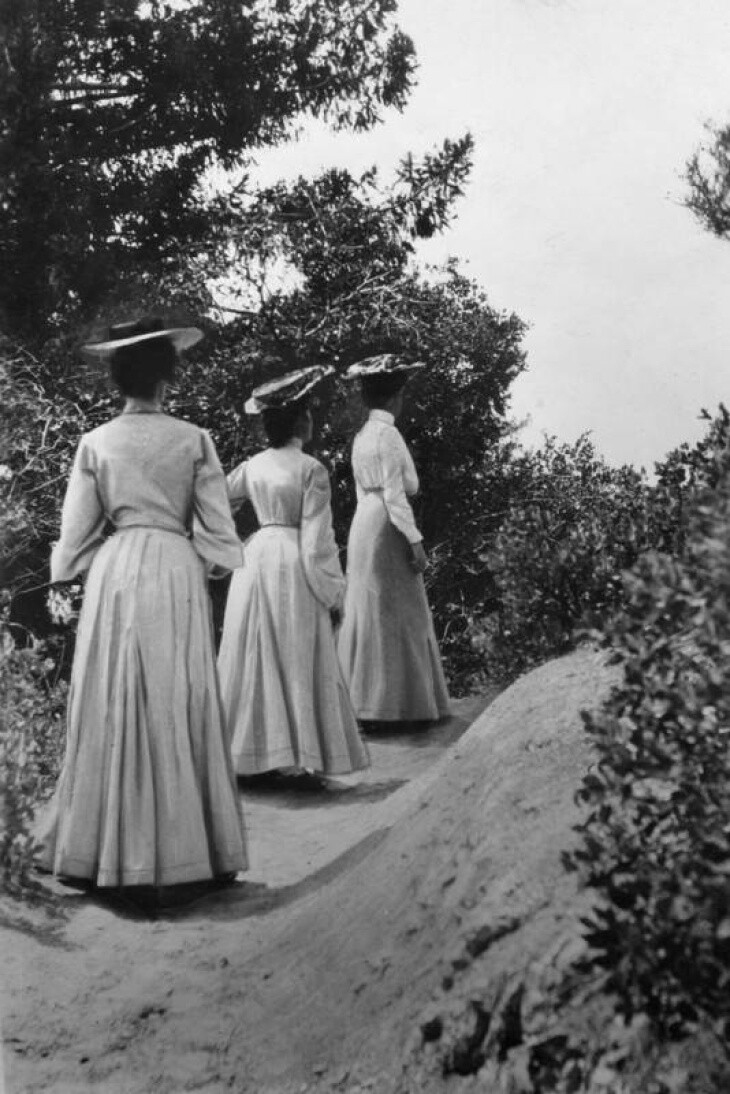
From the beginning of the American period in Los Angeles, city boosters sold Southern California to the rest of the world as an outdoor paradise, waiting to be discovered. "To our careless critics in the eastern press, who assume that everything here was lost in what they call a collapsed boom... can a man in health or a man out of health ask for any better home?" the Los Angeles Times asked in 1889. "The fact remains that outdoor life is possible and enjoyable here for 300 days of every year." Hiking would become an early expression of this SoCal spirit. "As far back as the late 1800s, the mountains of Los Angeles were drawing walkers to trails above the communities of Pasadena, Altadena and Sierra Madre — many of them trails left by the Gabrielino and Tongva native people and later developed and expanded by [naturalist and author] John Muir," Fleming says.
This enthusiasm for the outdoors led to the region's "Great Hiking Era," which ran roughly from the 1880s to the 1930s, according to historian Mark Landis.
"Hundreds, and perhaps even thousands of hikers used to travel up and down these trails every week-end," Arthur N. Carter wrote in a 1937 edition of Trails Magazine. "The procession of laughing and singing hikers would begin early Saturday afternoon and continue until dusk, or, on Sunday afternoon, the hikers came down, many of them foot-sore and subdued, and climbed onto the special Pacific Electric cars waiting to take them back to Los Angeles and adjacent towns."
These hordes of hikers were encouraged by an enthusiastic local press, which ran op-eds by doctors touting the health benefits of walking.

"Great is the joy of spending the entire time in the open air, among the trees and birds, where all is harmonious, at the seashore, the lake or mountain, where are found renewed vigor and health, after indulging in exercise of fishing, rowing, driving, riding, walking, hill or mountain climbing," the Los Angeles Times reported in 1904.
It was also an acceptable form of exercise for women and children. "Every woman who does not have active occupation should walk from three to five miles each day," a local doctor told the Los Angeles Times in 1893.
The "great outdoors," especially the areas owned and operated by the government, were technically open to everyone, regardless of race. People of color could use public trails, parks and boardwalks although they faced prejudice and were sometimes denied service by private vendors, according to historian Alison Rose Jefferson, author of Living the California Dream, African American Leisure Sites during the Jim Crow Era. "The civil rights laws said these places were open to all, but sometimes incidents of discrimination did happen," Jefferson tells LAist via email.

Some of L.A.'s early tastemakers and trendsetters were prodigious walkers and hikers.
"One of the leading citizens of the early Los Angeles metropolis was a prodigious walker," Fleming says. "Charles Lummis was working as a newspaperman in Cincinnati when, in 1884, he was offered a job by the Los Angeles Times. Lummis accepted and walked to work -- literally, covering more than 3,500 miles, on foot, over a four-month period. He was given the job of city editor when he arrived, and would later go on to work as city librarian and to found the Southwest Museum." According to historian Mark Landis, the first popular trail of the Great Hiking Era was in Arroyo Seco Canyon. It was built in the 1880s by Commodore Perry Switzer who also built a rustic camp approximately 15 miles up trail. It came to be known as Switzer Camp or Switzer-land.
"The going was a little tough... with some 60 stream crossings, either on foot or, twice a week, on a pack-mule," historian Paul R. Spitzzeri writes of the trail. "The reward, however, was the ability to camp in a gorgeous spot, including a nearby waterfall, just a short distance from 'civilization.'"
Other popular rest spots would soon open along Southern California's mountain trails.
"Nearby, a prospector named Charley Chantry built tents and hired donkeys to ramblers, and Chantry Flats, named after Charley, still offers donkey rentals at Adams' Pack Station," Fleming says. "You can hike Charley Chantry's trail past the site of his original campsites today. In Sierra Madre, you can still visit Lizzie's Trail Inn, which for 100 years outfitted hikers making their way up the Mt. Wilson Trail. Lizzie isn't selling meals anymore but people are still climbing the trail."

Hiking Mount Wilson, the peak of the San Gabriel Mountains, would also become a popular trip. "Pilgrims pass by in... khaki shorts, skirts, following the lead of puttee legging... Some 'hike' upwards without casting a look behind," the Los Angeles Times reported in 1909. "A large square pasteboard tacked to a tree naively announced that a couple are making the ascent on their very wedding day. The boulders are daubed with such messages as 'Hello, Bill,' [and] 'Keep moving,' in big capitals and red paint."

The payoff was at Mount Wilson's peak according to Times columnist Lee Shippey:
"One stirring hiking trip includes a start up the Mount Wilson trail at about 11pm which brings the hikers to the peak at about sunrise - the night view is one never to be forgotten. Here and there through the darkness, 6,000 feet below, the little starry towns bloom out, with great cities lying in the background like seas of light."

Promenades And Peacocks
Not everyone wanted to get that close to nature. For those who preferred more "civilized" roams, there were the wealthy and overwhelmingly white Victorian enclaves of Hollywood and Pasadena. The flowering grounds of painter Paul De Longpre's Hollywood estate, located at what is now Hollywood and Cahuenga boulevards, would become one of L.A.'s earliest walking meccas. Opened to the public in 1901, it was packed with day-trippers and tourists, who often found De Longpre strolling or painting in his garden.
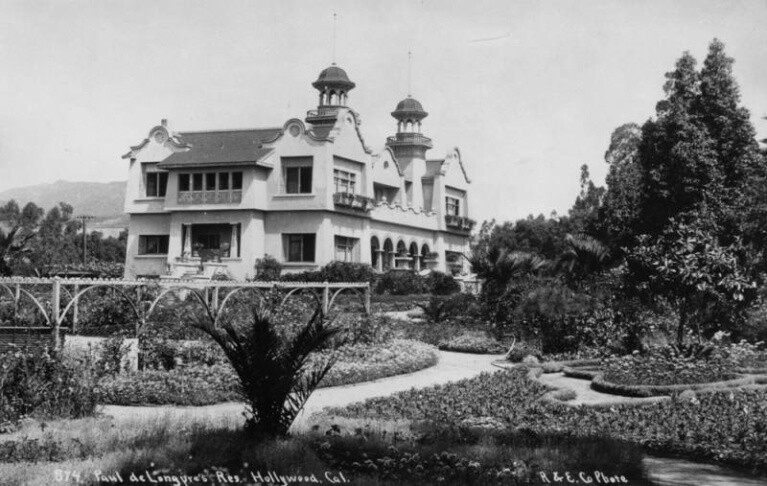
In 1907, the Los Angeles Times reported on a group of Shriners who had come to visit the gardens:
"In and out of the brilliant gardens there wandered such companies of the red-fezzed nobles and their wives and sweethearts that every walk was packed and every bower filled... In the pretty summer houses at various points through the grounds, refreshments were served by young ladies who carried baskets of the choicest flowers for distribution as boutonnieres and gave them out with winning smiles that at once made a hit with the Shriners."
De Longpre died in the house in 1911 and the estate, along with its beautiful gardens, was demolished in the 1920s.
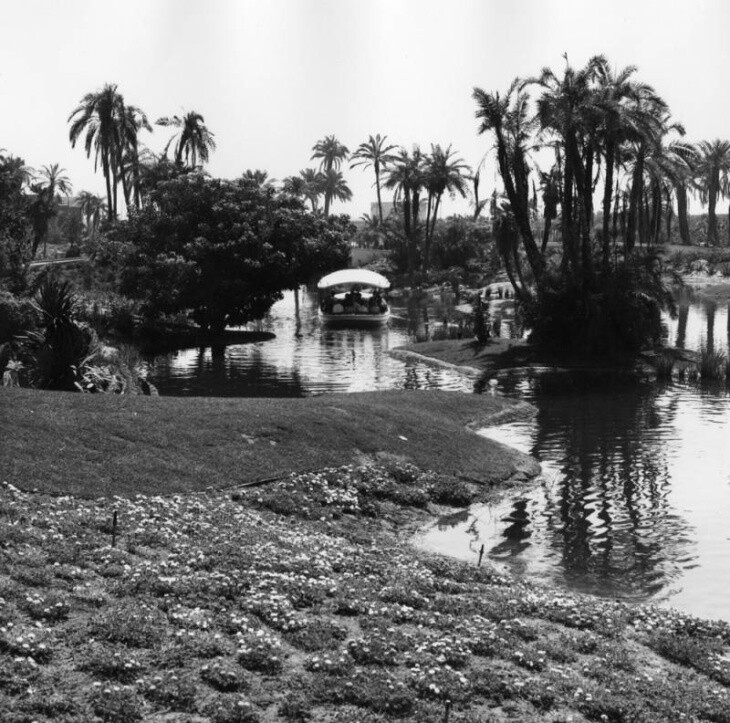
In 1909, beer baron Adolphus Busch and his wife, Lily, opened the gardens of their Pasadena estate to the public, giving birth to the original Busch Gardens.
Featuring a 14-acre, formally planted "upper garden" and a 16-acre, informal "lower garden," the Busch Estate, the ruins of which can still be seen today, attracted visitors from around the world.
"At times, it seemed that every walk in both gardens were crowded with sightseers. In addition to this, every seat was filled the greater part of the time. The day was delightful and almost everyone was out of doors," the Los Angeles Times reported in 1910.
The Great Hiking Era was also a time of expansion for L.A. County's public park system.

"I am drawn to water, so I love walking around Lake Hollywood or up to the lesser known Peanut Lake and around Echo Park's lake, MacArthur Park's lake and the former Eastlake, known now as Lincoln Park, and Hollenbeck Park," Fleming says. "These last four were constructed by the leaders of a new city that was determined to create safe, attractive spaces for people to enjoy the California sunshine they came to Los Angeles to find. More than a hundred years later, they're still doing that."

In the years before World War I, there was no better place to promenade and peacock than MacArthur Park (then known as Westlake Park), which was surrounded by what was, at the time, one of L.A.'s fanciest neighborhoods.
In 1896, the Los Angeles Times reported on a day filled with society swells:
"All day the walks were crowded... two well-dressed young men, with canes, gloves, stiff hats and all the gorgeous paraphernalia of the youth of the century, were wandering in majestic magnificence around the drive, when a puff of wind lifted the hats of both from their heads, gently depositing each under the wheels of a passing carriage... another man, who was escorting two ladies, and who was descanting fluently to them of the glories of the universe in general and Southern California in particular, was wandering near the edge of the boathouse platform, and calmly stepped over the edge into eight feet of water."
Even graveyards like Evergreen Cemetery (which had always been open to people of all races and religions, both for burial and visitation) and Hollywood Forever (which had not) were laid out as walkable parks, meant to be enjoyed in multiple ways — walking, carriage rides, picnicking, memorial events.

If a stroll among the dead wasn't your thing, there were the coastal boardwalks and piers. One of the most popular was the Long Beach Pike. Opened in 1902, its concrete walkway was 35 feet across and lit at night by twinkling Edison bulbs, hence its nickname, the "Walk of a Thousand Lights."
While all Southern Californians were technically allowed on the Pike, some of them faced racism and discrimination. In 1910 Charles Looff built a hippodrome on the Pike and banned Black patrons except at certain times. In an article for KCET, historian D.J. Waldie says Looff posted a sign that read:
"'Colored people and their friends are welcome after 9 o'clock Saturday nights.' When African-American visitors protested, Looff told the Los Angeles Times that "his amusement is run for ladies and children and he will not agree to any modification of his rules."
The Pike closed in 1979 but in its heyday, it was a place "where fully dressed vacationers could stroll, visiting the shops and other attractions on the land side of the walk, and stepping off the sand and water on the other side," according to historian Joan Mickelson. During the 1920s and 1930s, the number of Los Angeles parks, both public and private, boomed, feeding the popularity of walking and hiking as pastimes.
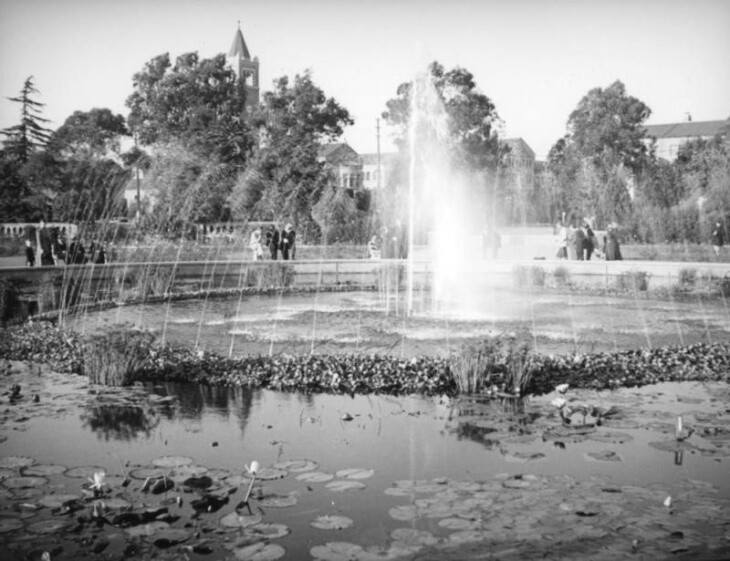
In 1927, the city-funded Exposition Park became a fashionable stroll when it was transformed into a resplendent rose garden with a central pond, pergolas and a fountain that changed color at night. Rachel Robinson, widow of baseball legend Jackie Robinson, recalled loving the garden as a child, the only place her mother would allow her walk alone.
A year later, Huntington Gardens, with its magnificent museum and formal gardens, opened in San Marino. Susan Turner-Lower, Vice President for Communications at the Huntington, says her research points to the gardens being open to people of all races (except for young children) from the start.

In the early 1930s, the weird and rustic Fern Dell opened in Griffith Park. According to the Los Angeles Times, a "walkway with rustic seats line the side of the ravine and occasionally cross the babbling stream on picturesque bridges built of stone and logs." The dell proved popular with photographers and tourists, who tramped in with buckets so they could drink the stream water, which they believed had been blessed with magical powers by Native Americans who once called the area home.
Although people of color were technically welcome to camp and hike in government-owned parks and nature reserves (such as Griffith Park and Catalina Island) and did so when they felt safe, they were often barred from beaches and swimming pools. So Black Southern Californians created their own resort centers. In Living the California Dream, Jefferson describes Val Verde, known as "the black Palm Springs," and Lake Elsinore, both of which boasted ample opportunities for swimming, camping and hiking in nature.
L.A.'s Great Hiking Era drew to a close in the late 1930s. World War II was on the horizon, and the rise of freeways and car culture made walking seem like a boring, old-fashioned pastime. But Southern California has never stopped delighting us with its walking paths, parks, hiking trails and outdoor wonders — and maybe the coronavirus pandemic will inspire people to seek them out.
-
Restored with care, the 120-year-old movie theater is now ready for its closeup.
-
Councilmember Traci Park, who introduced the motion, said if the council failed to act on Friday, the home could be lost as early as the afternoon.
-
Hurricane Hilary is poised to dump several inches of rain on L.A. this weekend. It could also go down in history as the first tropical storm to make landfall here since 1939.
-
Shop owners got 30-day notices to vacate this week but said the new owners reached out to extend that another 30 days. This comes after its weekly swap meet permanently shut down earlier this month.
-
A local history about the extraordinary lives of a generation of female daredevils.
-
LAist's new podcast LA Made: Blood Sweat & Rockets explores the history of Pasadena's Jet Propulsion Lab, co-founder Jack Parsons' interest in the occult and the creepy local lore of Devil's Gate Dam.



